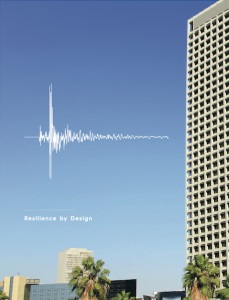
by Brianna Crandall — January 21, 2015—Los Angeles Mayor Eric Garcetti released the city’s exemplary Resilience by Design plan in recent weeks to address the city’s greatest earthquake vulnerabilities, including building retrofitting and steps to secure the water supply and communications infrastructure.
Mayor Garcetti’s Science Advisor for Seismic Safety Dr. Lucy Jones, a renowned United States Geological Survey seismologist, led the development of this report and assembled technical experts and consulted extensively in more than 150 meetings with businesses, property owners and other stakeholders to help inform the city’s action steps and advise on the specific devastation a major quake would bring. Dr. Jones was appointed in January under a unique partnership with the USGS.
“Los Angeles has always been an epicenter of seismic risk,” Mayor Garcetti said. “But today we are taking bold action to make LA an epicenter of earthquake preparedness, resilience and safety. Instead of being complacent and then jarred into action by a devastating earthquake, LA is moving forward proactively with a comprehensive package of preparedness and resiliency measures to fortify our buildings, protect our water supply, and keep our telecommunications online when the ‘Big One’ hits.”
Mayor Garcetti’s plan would require retrofitting of two types of vulnerable buildings. Retrofits would be required within five years at “soft-first-story” buildings built prior to 1980, and retrofits would be required within 25 years at “non-ductile reinforced concrete” buildings built prior to 1980.
The plan recommends significant investments in fortifying the city’s water supply, including developing an alternative water system for firefighting, protecting aqueducts that cross the San Andreas Fault, increasing local water sources, and developing a network of resilient pipes.
The plan also calls for upgrades to the city’s telecommunications network to enable Internet and mobile connectivity after an earthquake, including creating partnerships with providers for shared broadband services after disasters, protecting power systems at fault crossings, creating a solar-powered citywide Wi-Fi network to avoid power disruptions, and fortifying cell phone towers.
“We acknowledge that we cannot prevent 100% of the losses in an earthquake. What we are trying to do is prevent the catastrophic collapse of our economy by addressing the biggest vulnerabilities,” said Dr. Lucy Jones. “And if all of these recommendations are enacted, I believe that Los Angeles will not just survive the next large earthquake, but we will be able to recover quickly and thrive.”
An executive summary and the entire Resilience by Design report are available on the mayor’s Web site.
“As one of the premiere organizations representing commercial building owners, BOMA Greater Los Angeles has appreciated the strong leadership provided by Mayor Eric Garcetti and Dr. Lucy Jones on seismic retrofit. The process has been open and collaborative, which is crucial to enhancing building resilience, protecting tenants, and preserving a vital economic base in Los Angeles,” said Michele Ware, president of the Building Owners and Management Association of Greater Los Angeles (BOMA/GLA).
The City of Los Angeles Department of Building and Safety has committed to establishing a specialized unit dedicated to implementing the recommendations contained within this report. Services provided by this unit will include preparation of construction retrofit standards, easy-to-follow guidelines, public outreach workshops, and expedited plan review and inspection approval process, according to Raymond Chan, general manager, DBS.
The U.S. Resiliency Council supports the mayor’s recommended program, which includes the voluntary use of the USRC Building Rating System for the Earthquake Performance of Buildings. The system, which communicates the risk of earthquake hazards in consistent, reliable, and understandable terms, will inform owners, tenants, buyers and sellers, lenders and insurers, and policy makers, about the performance of the buildings in which they live, work and invest. Los Angeles will be the first city in the world to adopt the rating system.
“The public generally holds to the misconception that a building built to modern codes in California is ‘earthquake proof,'” commented Ron Mayes, executive director of the USRC. “In fact, even the current code is only intended to produce buildings that avoid collapse in a large, rare event such as a repeat of the 1906 San Francisco Earthquake. The possibility that hundreds or thousands of newer structures might be left uninhabitable, nonfunctional and essentially total losses after such an event nonetheless conforms to the Building Code’s intent, even though such an outcome would not meet the public’s expectations, who expect their communities and businesses to rebound quickly. Christchurch, New Zealand, was a very recent example of a major city in an earthquake-prone area that was subjected to its maximum credible earthquake. Only two building collapsed during the February 2011 event, but 70% of the buildings in the downtown have now been demolished.”
The Structural Engineers Association of Southern California (SEAOSC), representing the local structural engineering community, also commends Mayor Garcetti and his office for bringing stakeholders together on the plan. SEA of Northern California created the first rating system that USRC adopted, mentioned above. The city sought the expertise of the structural engineering community on how to structurally address these issues, while also partnering with building owners for implementing timelines to complete the seismic retrofitting programs for the types of buildings involved.
“We congratulate the Mayor’s office for taking the stance that Los Angeles will be the first city in the nation to rate the earthquake performance of publicly owned buildings. Once rated and publicly posted, the ratings will help Angelinos’ understand the City’s commitment to safe public buildings and hopefully encourage other building owners to get their buildings rated as well,” commented Michael Cochran, president of SEAOSC.
The Los Angeles Times has featured numerous resources related to the proposal, including an article: “Mayor Garcetti’s quake retrofit plan draws cautious early support;” a chart: “Chart: L.A. mayor’s proposals for concrete, wood quake retrofits;” an infographic: “How concrete buildings fail in earthquakes;” and a preliminary map of a section of the Hollywood fault from the California Geological Survey: “Fly over the Hollywood fault zone.”




